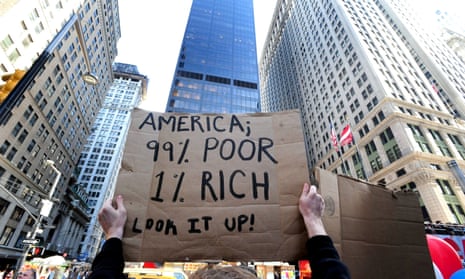The CEO of Marathon Petroleum, Gary Heminger, took home an astonishing 935 times more pay than his typical employee in 2017. In other words, one of Marathon’s gas station workers would have to toil more than nine centuries to make as much as Heminger grabbed in just one year.
Employees of at least five other US firms would have to work even longer – more than a millennium – to catch up with their top bosses. These companies include the auto parts maker Aptiv (CEO-worker pay ratio: 2,526 to 1), the temp agency Manpower (2,483 to 1), amusement park owner Six Flags (1,920 to 1), Del Monte Produce (1,465 to 1), and apparel maker VF (1,353 to 1).
These revelations come thanks to a new federal regulation that requires publicly traded US corporations to disclose, for the first time ever, how much their chief executives are making compared with their median workers. The disclosures are just now starting to flow in.
Up until this year, comparisons of CEO and worker pay have had to rely on the average take-homes of US workers overall – not the pay of workers at individual corporations. Those generalized figures helped us track the soaring trajectory of executive compensation at big US corporations, from 30 times average worker pay in the 1960s to over 300 times more recently.
But headlines around those average figures did next to nothing to slow our CEO pay-hike express. Will the release of the ratios at individual corporations make any more of a difference?
Corporate America must surely think so. Ever since 2010, the year Congress plugged a ratio disclosure mandate into the Dodd-Frank financial reform act, corporate lobbyists have been scheming to delay and repeal that mandate’s implementation. But responsible investors and other activists rallied and kept the mandate in place.
The new ratios offer a benchmark for corporate greed that exposes exactly which firms are sharing the wealth their employees create and which aren’t, knowledge we can use to impose consequences on the corporations doing the most to make the United States more unequal.
What sort of consequences?
In Oregon, the city of Portland has adopted what the economist Branko Milanović has labeled “the first tax that targets inequality as such”. Portland’s new levy imposes a 10% business tax surcharge on companies with top execs making over 100 times their median worker pay – and a 20% surcharge on firms with pay gaps that stretch past 250 times.
City officials in San Francisco are bringing a similar measure before voters this November. At the state level, lawmakers in Minnesota, Rhode Island, Connecticut, Illinois, and Massachusetts are getting into the pay-ratio tax act as well.
In California, a state senate bill that took the same approach nearly passed. The key sponsor of that measure, Mark DeSaulnier, now sits in Congress, where he’s co-sponsoring a like-minded federal bill.
Other lawmakers are advancing proposals to link government procurement to pay ratios. Existing public policies deny government contracts to companies with employment practices that contribute to race and gender inequality. Why should tax dollars be subsidizing firms that increase economic inequality?
In Rhode Island, a pending Senate bill would give preferential treatment in state contracting to corporations that pay their CEOs no more than 25 times their median worker pay. Several congressional offices are now preparing legislation that aims in the same direction.
Even some Republicans have shown interest in leveraging the power of the public purse against firms that pay top execs astronomically more than workers. In 2015, then Republican congressman (now the White House budget director) Mick Mulvaney tried to prevent the US Export-Import Bank from subsidizing any company with CEO pay over 100 times median worker pay. Lawmakers could easily apply the same standard to other forms of corporate welfare.
Ratio disclosure also opens doors for trade unions to bring demands tied to pay gaps into collective bargaining. Consumers can shun corporations that lavish pay on their top execs at the expense of their employees. Investors can put their 401(k) dollars in mutual funds that screen out corporations with chronic pay-gap excess.
All this activity could make a significant dent in inequality. Corporate execs today head up about two-thirds of America’s top 1% households.
We don’t have to just complain any more about runaway executive pay. Now we can make corporations that pay their CEOs unconscionably more than their workers change their ways – or pay the consequences.
- Sarah Anderson has been the lead author on the annual Institute for Policy Studies Executive Excess reports since 1994. She co-edits Inequality.org with Sam Pizzigati. His latest book, The Case for a Maximum Wage, will appear this spring
